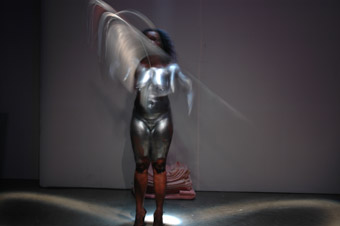 |
Sonia Beltran Napoles, Hey Girl!, Socìetas Raffaelo Sanzio photo Raffaelli |
Visual elements drive the work from moment to moment. Precisely focussed lights pick out the next object that will shape the action – a sword, a drum, a man watching. Careful staging draws our eye to each new tableau as if to a specific point on the canvas. Spoken text is rare, and always whispered, so as not to impinge on this dreamy, fog-laden visual world. Even the main character, the iconic Girl of the title (Sylvia Costa), is an image resolving out of an abandoned, amorphous glob of thick paint left heaped on a table. The skin-tone paint she emerges from never stops dripping onto the floor during the whole mesmerizing length of the work.
This is a polyptych – a many-panelled work of art, imprecisely seen through the smoke of ages, like the dust that collects on an old painting. On this panel, over here, is the bird that can no longer fly, and the violent crowd. On this panel is the other side of the Girl, the dark half who is enslaved to a man. On another panel is a newborn woman, weeping. Castellucci places the Girl stage front, listening to the brutal light of the Divine – in this case a laser beam. He shows us the Girl comforting herself in the person of another woman who bears an enlarged copy of the Girl’s head. In creating these moments, he’s suggesting what an allegorical painting would look like, if it came to life before us in three dimensions.
The challenge with allegorical painting – more typically a product of the Renaissance – is that the modern audience is out of practice reading the symbols. Castellucci has updated the images, but some mystery remains. How literal is the reading intended to be, and how much reading should we do?
The girl kneels before a large, metal sword. Slowly, exquisitely slowly, she reaches across and picks up a lipstick case I didn’t notice until just before her hand touched it. She puts the lipstick on. Then she places it on the sword and smoke rises. Reaching over to a bottle of perfume, she draws the scent onto her skin with a throat-slitting gesture. Poured over the sword, the perfume steams and sizzles and the theatre fills with a hot fragrance. The Girl soothes the angry sword with a folded pink sheet and recites the names of dead queens. Marie Antoinette. Ann Boleyn. The Russian Tsarina. She lifts the burning blanket and unfolds it, a dark brown X revealed, newly branded. “These are the queens who lost their head on account of the people,” she whispers.
A bald description of the Girl’s gestures does not convey the ritual power contained in each tableau. The impulse is to search for meaning, although following that impulse feels like an inadequate approach to the work. Certainly, there are multiple ways the scene above could be read. Most obviously, the lipstick and perfume signify the queens of history, the women with power who were destroyed by men. Alternatively, these are symbols of femininity that at various times have been rejected as disempowering. There are other possibilities, but the actual interpretation may be less important than the attempt to interpret. The pace of the piece is ritualistically slow, giving plenty of time for conjecture.
Hey Girl! is an extremely unusual work by a director with that rarest of qualities – a unique vision. It’s exactly the kind of work I hope to see at Vancouver’s PuSh Festival, which aims to present the best of contemporary work, including more risky and challenging pieces. It’s not like anything I’ve seen before outside the visual arts, and Hey Girl! makes me realize how much room there is to develop the images of live theatre. Castellucci expands our ability to read those images in places we never expected to see them. But he also creates a world in which humans move through a landscape full of symbols without ever trying to interpret them at all. Maybe that’s what we’re doing every day, but the layer of paint he applies allows us to see it for the first time.
Socìetas Raffaelo Sanzio, Hey Girl!, director, design, lights, costumes Romeo Castellucci, performers Silvia Costa, Sonia Beltran Napoles, original music Scott Gibbons, statics and dynamics Stephan Duve, lighting technique Giacomo Gorini, Luciano Trebbi, sculptures Plastikart, Istvan Zimmerman; Frederic Wood Theatre, University of British Columbia, Jan 23-26; PuSh International Festival of Performing Arts, Jan 16-Feb 3
Anna Russell is a Vancouver writer and filmmaker who is also an analyst with the Canadian Federal Government.
© Anna Russell; for permission to reproduce apply to [email protected]








 back
back